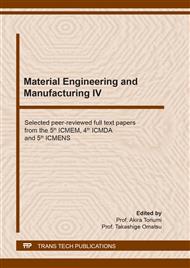[1]
Marom R , Amalraj S F , Leifer N , et al. A review of advanced and practical lithium battery materials. Journal of Materials Chemistry, 2011, 21(27):9938-9954.
DOI: 10.1039/c0jm04225k
Google Scholar
[2]
Barghamadi M, Kapoor A, Wen C. A Review on Li-S Batteries as a High Efficiency Rechargeable Lithium Battery. Journal of the Electrochemical Society, 2013, 160(8): A1256-A1263.
DOI: 10.1149/2.096308jes
Google Scholar
[3]
Armstrong A.R, Lyness C, Panchmatia P.M, et al. The lithium intercalation process in the low-voltage lithium battery anode Li(1+x)V(1-x)O2. Nature Materials, 2011, 10(3):223-9.
DOI: 10.1038/nmat2967
Google Scholar
[4]
Li Z, Zhao H, Lv P, et al. Watermelon‐Like Structured SiOx–TiO2@C Nanocomposite as a High‐Performance Lithium‐Ion Battery Anode. Advanced Functional Materials, 2018, 28(31).
DOI: 10.1002/adfm.201605711
Google Scholar
[5]
Cao X , Shi Y, Shi W, et al. Preparation of MoS2-coated three-dimensional graphene networks for high-performance anode material in lithium-ion batteries. Small, 2013, 9(20): 3433-3438.
DOI: 10.1002/smll.201202697
Google Scholar
[6]
Hwang H , Kim H , Cho J . MoS2 Nanoplates Consisting of Disordered Graphene-Like Layers for High Rate Lithium Battery Anode Materials. Nano Letters, 2013, 11(11): 4826-4830.
DOI: 10.1021/nl202675f
Google Scholar
[7]
Guo X, Xie X, Choi S, et al. Sb2O3/MXene(Ti3C2Tx) hybrid anode materials with enhanced performance for sodium-ion batteries. Journal of Materials Chemistry A, 2017, 5(24).
Google Scholar
[8]
Wang S, Wang Q, Zeng W, et al. A New Free-Standing Aqueous Zinc-Ion Capacitor Based on MnO 2 –CNTs Cathode and MXene Anode. Nano-Micro Letters, 2019, 11(1):1-12.
DOI: 10.1007/s40820-019-0301-1
Google Scholar
[9]
Kong W, Yu J, Shi X, et al. Encapsulated Red Phosphorus in rGO-C3N4 Architecture as Extending-Life Anode Materials for Lithium-Ion Batteries. Journal of The Electrochemical Society, 2020, 167(6):060518.
DOI: 10.1149/1945-7111/ab8406
Google Scholar
[10]
Tianbing S, Hai C, Zhi L, et al. Creating an Air-Stable Sulfur-Doped Black Phosphorus-TiO_2 Composite as High-Performance Anode Material for Sodium-Ion Storage. Advanced Functional Materials, 2019, 29(22):1900535.
DOI: 10.1002/adfm.201900535
Google Scholar
[11]
Daniel T. Larson, Ioanna Fampiou, Gunn Kim, and Efthimios Kaxiras, Lithium Intercalation in Graphene–MoS2 Heterostructures, J. Phys. Chem. C 2018, 122, 43, 24535–24541.
DOI: 10.1021/acs.jpcc.8b07548
Google Scholar
[12]
Aierken, Y, Sevik, et al. MXenes/graphene heterostructures for Li battery applications: a first principles study. Journal of Materials Chemistry A, 2018, 6, 2337.
DOI: 10.1039/c7ta09001c
Google Scholar
[13]
Ilker, Demiroglu, François, et al. Alkali Metal Intercalation in MXene/Graphene Heterostructures: A New Platform for Ion Battery Applications. The journal of physical chemistry letters, 2019 10, 727−734.
DOI: 10.1021/acs.jpclett.8b03056
Google Scholar
[14]
Wang L, He X, Li J, et al. Nano-Structured Phosphorus Composite as High-Capacity Anode Materials for Lithium Batteries. Angewandte Chemie International Edition, 2012, 51, 9034-9037.
DOI: 10.1002/anie.201204591
Google Scholar
[15]
Wang R, Dai X, Qian Z, et al. Boosting Lithium Storage in Free-Standing Black Phosphorus Anode via Multifunction of Nanocellulose. ACS Applied Materials & Interfaces, 2020, 10.1021/acsami.0c08346.
DOI: 10.1021/acsami.0c08346
Google Scholar
[16]
First principles methods using CASTEP, Zeitschrift fuer Kristallographie 220(5-6) pp.567-570 (2005).
Google Scholar
[17]
J. P. Perdew, K. Burke, and M. Ernzerhof, Generalized gradient approximation made simple, Phys. Rev. Lett. 77, 3865 (1996).
DOI: 10.1103/physrevlett.77.3865
Google Scholar
[18]
G. Stefan, E. Stephan, and G. Lars, Effect of the damping function in dispersion corrected density functional theory, J. Comput. Chem. 32, 1456 (2011).
Google Scholar


